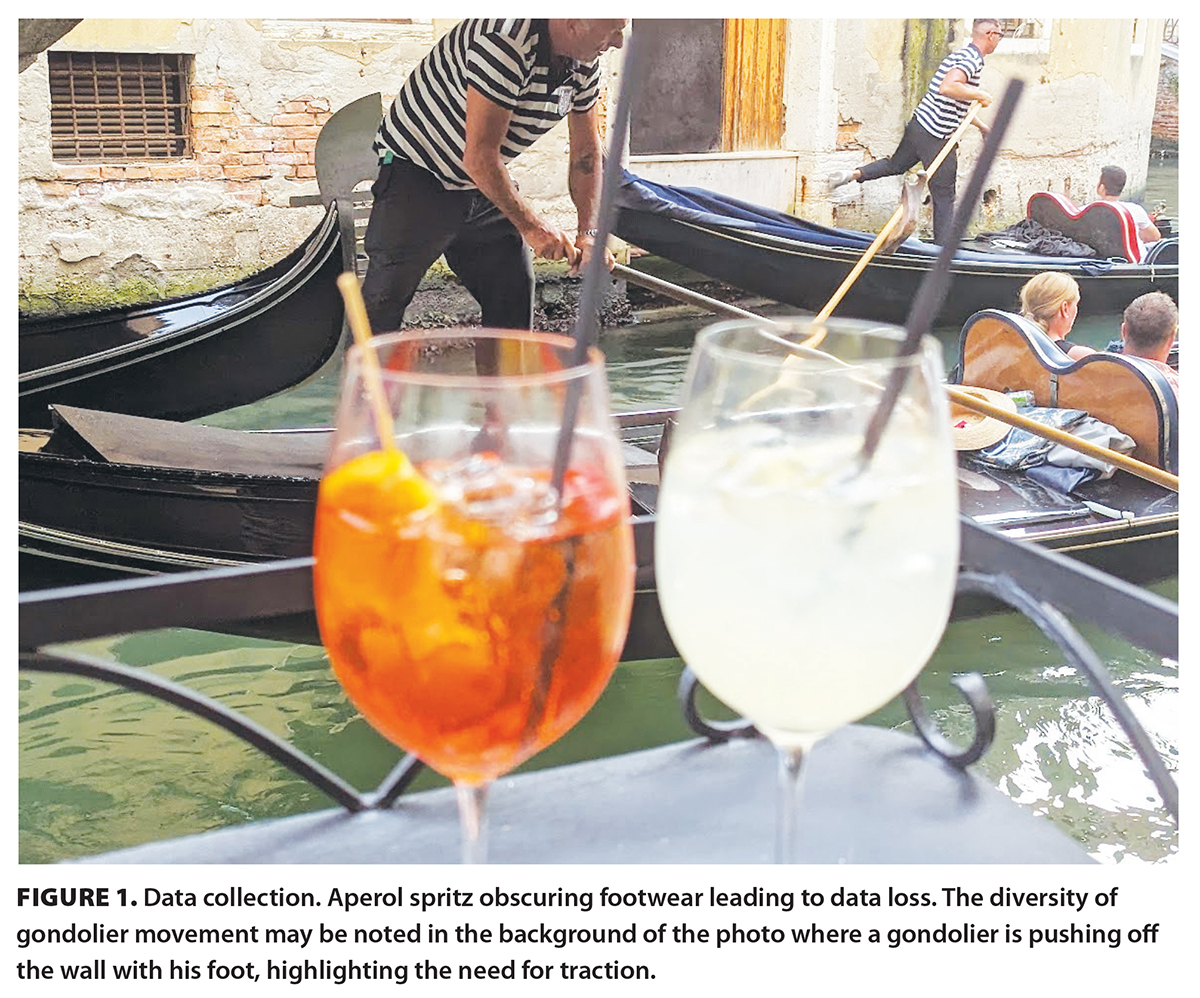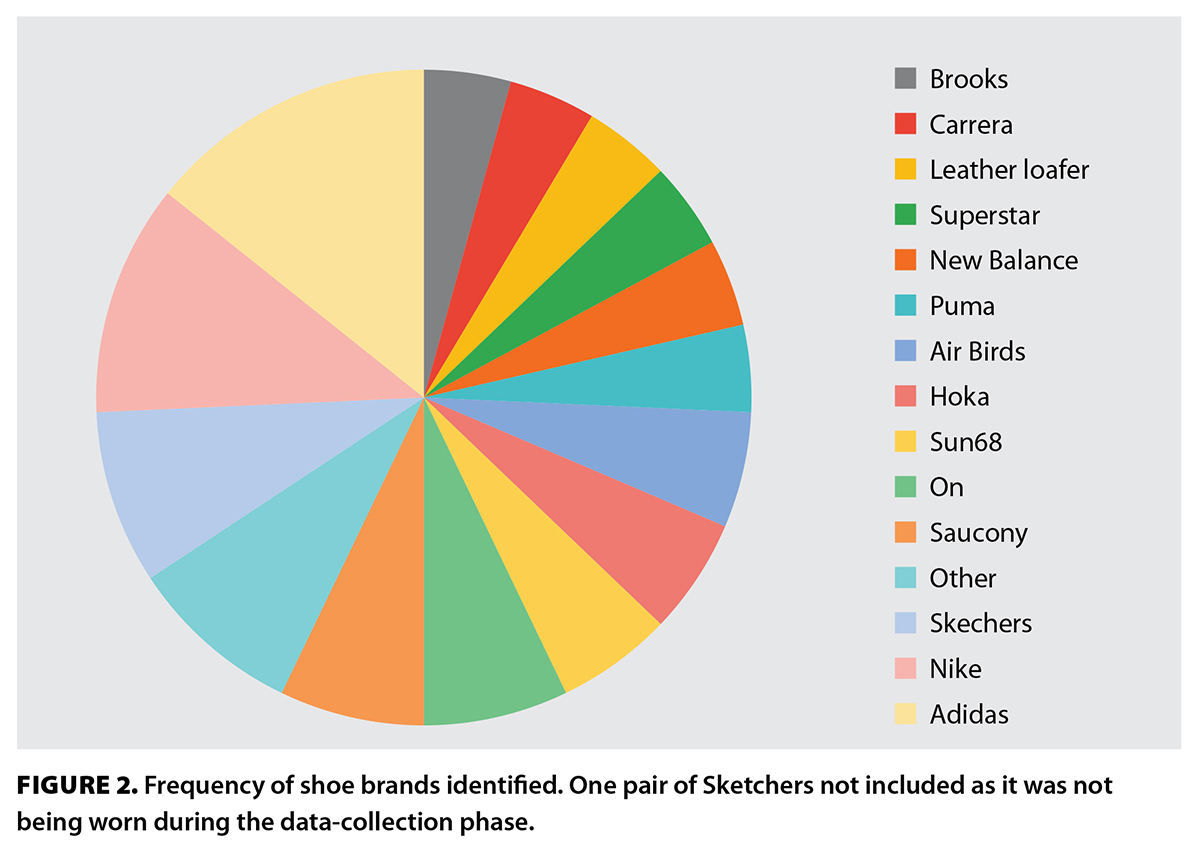Subclinical: Gondoliers’ footwear
ABSTRACT: Gondoliers, often overlooked in the realm of occupational safety, navigate the intricate waterways of Venice while providing essential services to wealthy tourists. The footwear choices of these professionals are crucial for their performance, especially on wet, unstable surfaces. This groundbreaking study sheds light on the diversity of gondoliers’ footwear preferences. Analyzing 74 discreetly photographed gondoliers on a tax-deductible research trip, the authors have shone light on a new area of academic inquiry. The greatest strength and simultaneous weakness of this study involved the researchers being blinded through the befuddling effects of Aperol. Other beverages will be considered to reduce investigator bias in future research of this series.
A capricious survey of shoe choices among Venetian watercraft operators.
Introduction
Despite their crucial role in Venice’s tourism industry, gondoliers remain understudied. There are no prior investigations into their footwear choices. In fact, a PubMed search returned no results for the search terms “Venetian boatman” or “gondolier.” Operating within the confines of a UNESCO World Heritage Site, these skilled professionals engage in high-risk activities on slippery surfaces. Their tasks range from propelling vessels to assisting passengers, which often requires strength and agility. This study begins the exploration of their footwear preferences, with the expectation that future research will enable safety recommendations. It is our aspiration that an exhaustive series of studies will not only advance knowledge but also facilitate investigator tax deductions for European travel research expeditions.
Methods
 The methodology involved discreetly capturing images of 74 consecutive gondolier footwear selections while seated at a bar along the Grand Canal. A Google Pixel 7 cellphone was used for the remarkable zoom capabilities of the purpose-acquired device (which the authors believe to be tax-deductible). To ensure impartiality, gondoliers remained unaware of being photographed, and the researchers consumed numerous Aperol spritzes and one limoncello. Researcher inebriation was a great asset to this study. Post–data collection, when the researchers had sobered from the exhaustive 3-hour session, footwear photos were carefully analyzed. Attempts to conduct interviews with the gondoliers proved futile due to diminishing communication skills, although the researchers’ inability to speak Italian was not felt to be an impediment to the attempts. Exclusion criteria were based mainly on low-quality photos caused by the optical effects of wine glasses obscuring the view of gondoliers’ feet [Figure 1].
The methodology involved discreetly capturing images of 74 consecutive gondolier footwear selections while seated at a bar along the Grand Canal. A Google Pixel 7 cellphone was used for the remarkable zoom capabilities of the purpose-acquired device (which the authors believe to be tax-deductible). To ensure impartiality, gondoliers remained unaware of being photographed, and the researchers consumed numerous Aperol spritzes and one limoncello. Researcher inebriation was a great asset to this study. Post–data collection, when the researchers had sobered from the exhaustive 3-hour session, footwear photos were carefully analyzed. Attempts to conduct interviews with the gondoliers proved futile due to diminishing communication skills, although the researchers’ inability to speak Italian was not felt to be an impediment to the attempts. Exclusion criteria were based mainly on low-quality photos caused by the optical effects of wine glasses obscuring the view of gondoliers’ feet [Figure 1].
Discussion
 The results indicate a notable diversity in the footwear choices of gondoliers, with some trends emerging [Figure 2]. Predominantly, minimalist shoe brands such as Nike (10.8%) and Adidas (13.5%) were common. However, intriguing anomalies included the maximalist Hoka shoes, representing 5.4% of all footwear observed. Notably, one gondolier was observed barefoot, with cushioning Skechers left on the boat’s deck. The significance of this observation remains unclear, as Skechers were a prevalent choice among study subjects. Interviews with less-intoxicated data collectors might be of benefit. Future studies should aim to better manage researcher inebriation levels. Additionally, potential secondary endpoints, such as the correlation between red- or black-striped shirts and shoe types, could be explored with a larger sample size.
The results indicate a notable diversity in the footwear choices of gondoliers, with some trends emerging [Figure 2]. Predominantly, minimalist shoe brands such as Nike (10.8%) and Adidas (13.5%) were common. However, intriguing anomalies included the maximalist Hoka shoes, representing 5.4% of all footwear observed. Notably, one gondolier was observed barefoot, with cushioning Skechers left on the boat’s deck. The significance of this observation remains unclear, as Skechers were a prevalent choice among study subjects. Interviews with less-intoxicated data collectors might be of benefit. Future studies should aim to better manage researcher inebriation levels. Additionally, potential secondary endpoints, such as the correlation between red- or black-striped shirts and shoe types, could be explored with a larger sample size.
Conclusion
This preliminary investigation highlights the considerable diversity in footwear choices among professional gondoliers. Looking toward future exhaustive studies, we hope to embark on tax-deductible research expeditions to further explore this fascinating topic.
This article has been peer reviewed.
 |
| This work is licensed under a Creative Commons Attribution-NonCommercial-NoDerivatives 4.0 International License. |
Dr Zanbilowicz is a podiatrist practising at the Caledonian Clinic in Nanaimo with a master’s degree in medical education from McGill and a Yozma Fellowship to Yale University. He completed his surgical residency in Vancouver in 2000. Dr Zanbilowicz was the principal researcher and creator of a physician-initiated Pfizer study on prophylaxis of postoperative orthopaedic pain using Celebrex (the study was not published due to insufficient patients being recruited). He has also served on the BC Podiatric Medical Association board, has been a keynote lecturer at wound care conferences, and is beginning to work as part of the peer review practice standards assessment group through the College of Physicians and Surgeons of BC. Ms Zanbilowicz is an undergraduate student in the health sciences program at Queen’s University in Kingston, Ontario. She is also an outreach committee executive for MOVE4MANA Canada and co-author of Introduction to Statistics for the Health Sciences, a textbook pending publication at Queen’s University.
